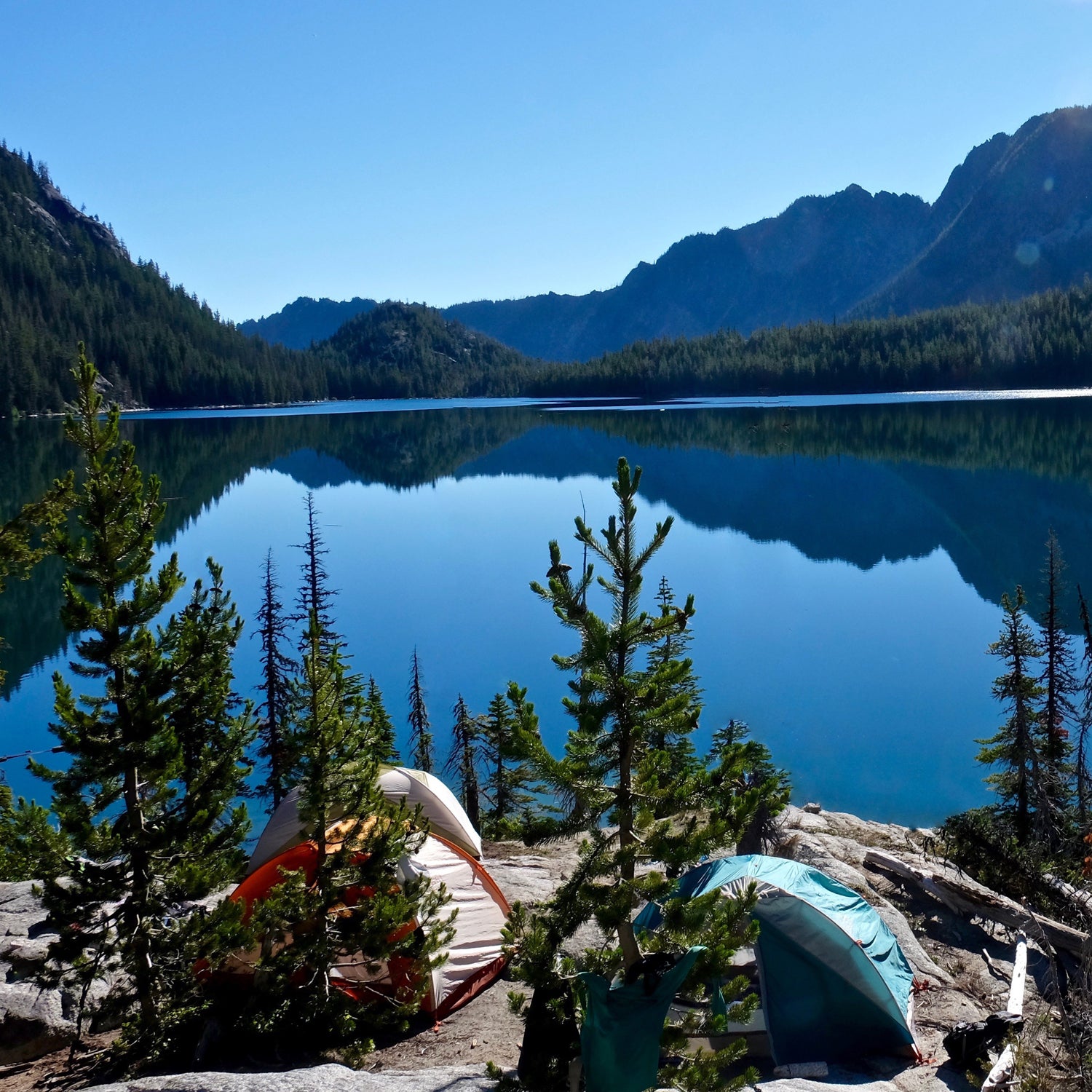You had a summer for the ages. Bike trips. Weekends surfing. You summited that mountain you’ve always wanted to summit. Got a tan. Bucket list stuff. You know what would make you summer even better? One more camping trip to someplace epic. The problem? Impromptu camping trips can be hard to pull off, especially if you have your heart set on one of our popular national parks, where reservations often need to be secured months in advance. Have no fear; many national parks designate some of their campgrounds as first come, first serve only—ideal for last minute, end of the season camping trips. Show up early in the morning to grab an open spot (or maybe skip a day of work) and you’ll have some of the most iconic landscapes out your tent flap.
Colonial Creek Campground, North Cascades National Park
We know Olympic National Park is awesome (that lush forest! That coast line!), but North Cascades, Washington’s other national park, has the goods too, with a fraction of the crowds. North Cascades gets just 25,000 visitors each year, but has earned the nickname The American Alps thanks to its snowcapped peaks, abundance of glaciers (almost 300 at last count), and milky blue rivers and lakes. And puts you in the heart of the action. This is the largest campground on this list (142 sites), but that means you’ll have a good chance of finding an open spot, even on a weekend. Show up early in the morning or midweek, and you’ll get to choose from sites tucked into an old growth forest, or tent pads on the edge of Diablo Lake. Head straight for the south loop, where most of the lakeside sites reside (they’re open until late September). From there, you’ll also have quick access to the boat launch and Thunder Creek Trailhead.
Colonial Peak and its white glaciers dominate the view, while kayaking Diablo Lake will dominate your itinerary. The reservoir gets its powdery blue pallor from the surrounding glaciers grinding rocks into a fine powder. A handful of islands provide paddlers with destinations, and hikers should explore Thunder Creek Trail, which follows the glaciated river of the same name as it makes its way from old growth to Fourth of July Pass. $16 a night.
Lava Point, Zion National Park
Utah’s first national park actually has a soft spot for last-minute campers; their large South Campground, near the entrance to the park, is all first come, first serve and has some pretty sweet sites near the Virgin River. But you’re going to drive right past the crowds to , a tiny loop with just six primitive sites sitting off the dirt Kolob Terrace Road, one hour from the visitor center. You’ll have to be self-sufficient, but you’ll be perched at almost 8,000 feet, well above Zion’s infamous heat, under the shade of aspens and pines. A short trail leaving from the campground loop leads to Lava Point Overlook, offering a top-down view of Zion Canyon. If you have the skills and a permit, Lava Point is also the perfect base camp for exploring Zion’s famous “Subway,” an extremely narrow portion of the Left Fork of North Creek that feels a bit like an underground train tunnel.
Slough Creek Campground, Yellowstone National Park
There are two Yellowstones; the one where you stand shoulder to shoulder with hundreds of strangers watching hot water spew out of the earth (which is cool, even if you’re three deep looking over some bald guy’s head), and then there’s Yellowstone’s backcountry, which is ripe with trout streams, canyons, and meadows. Snag a spot at the , in the northern edge of the park, and you’ll be in the thick of Yellowstone’s wilder side. The campground is small, just 23 sites, many of which sit on the bank of its namesake stream, a wide and shallow river that curves through a mix of open meadows and steep canyons. Choose from meadow, forested or river sites, all of which are generator-free, which means you can listen for wolves in the middle of the night instead of the low hum of an engine. Fishing Slough Creek is the thing here. You’re hunting for 12-inch cutthroat trout in the pools below the shoals right next to the campground. At dusk, wander to the edge of one of the nearby sage meadows and wait for elk and bison to come to dinner. The 23 sites at Slough fill up fast. If you can swing a midweek trip, you’ll be fine. Otherwise, show up early in the morning for an opening. The park service operates a page . $15 a night; Slough Creek usually closes in mid September.
Garden Key Campground, Dry Tortugas National Park, Florida
You might have already had a beach trip this summer, but we guarantee it was nothing like what you’ll find in Dry Tortugas National Park, a collection of seven islands 70 miles west of Key West. Most of the parks’ 100 square miles is open water, covering the southern tip of one of the greatest reef systems in the world. In other words, Dry Tortugas offers some of the best snorkeling and diving in the U.S. A massive stone fort and former federal prison dominates , where you’ll pitch your tent in the small, 10-site campground tucked between a swimming beach and the boat launch. While the campground is small, the park service guarantees campers will have a place to pitch their tent if they show up prepared. Spend your days swimming and snorkeling around Garden Key, where you’ll see eels, nurse sharks, and squid amongst the reef and wrecks surrounding the island. Bring a kayak and you can paddle three miles to Loggerhead Key, where you can explore famous dive sites like Little Africa (a collection of coral that looks like the continent) and Windjammer (a shallow ship wreck). If you’re lucky, the sandbar between Garden Key and its closest neighbor, Bush Key, will be exposed forming a land bridge between the two islands. The park is only accessible by boat or plane. Unless you have a seaplane (which would be awesome, and we should definitely be friends) your best bet is to catch the Dry Tortugas National Park Ferry, which runs daily from Key West. It’s a two-hour ride each way. The ferry runs $195 per person, camping is $15 to $30 a night for your whole party.
Balsam Mountain Campground, Great Smoky Mountains National Park
The crowds that flock to Great Smoky Mountains National park are well documented, but the vast majority of those nine million annual visitors stick to a single road cutting through the middle of the park. is perched a mile high on the eastern edge, about as far away from everyone else as you can get. There are 46 sites scattered amongst the hardwoods and spruce fir forest; try to snag a spot in the small loop of tent-only sites for maximum seclusion. The Cataloochee Divide Trail, one of the least traveled paths in the park, begins near the campground, taking you by massive old growth hemlocks and over high-elevation balds with expansive views. But really, you need to bring your road bike. The campground sits at the point where the Blue Ridge Parkway meets Great Smoky Mountains National Park. The southern end of the parkway has some of the most scenic road biking in the East, including 6,410-foot Richland Balsam, the highest point along the road, which feels like a slice of Colorado with its boulder and evergreen-laden slopes. Balsam Mountain Road, which heads in the other direction from the campground, might be the coolest (and least traveled) dirt road in the park as well. $14 a night.


